Key Takeaways from Zendesk’s Customer Experience Council

Customer Success. It sounds great. I mean, it definitely has a nice ring to it. But, what does it really mean? I’d say it’s obvious every company should want to secure the success of their customer base- a company simply can’t survive without happy customers. However, to many people (ahem… me!) this new field and its ramifications can seem overwhelming and hard to actually implement. Where do you even start? How can you make sure you’ve effectively approached your customer base? Which tactics will your customers find actually help them reach their goals?
These questions are super common to anyone exploring the field of Customer Success. Whether you’re looking to implement a customer success department in your company, or simply exploring the benefits and tactics of this strategic approach, it’s completely OK to be asking yourself these questions!
Personally, I just graduated from University with a business degree and had never even heard the terms “customer Experience” or “Customer Success” before I started working for Userlane. At Userlane, it’s our mission to enrich people’s lives by making it easy to understand and operate software. Customer Success is at the core of our reason for being; we simply want to make sure that our customers reach their goals!
Now, before you decide to stop reading this article because I’ve just disclosed my novice Customer Experience status, you should know that I consider myself to be somewhat of an obsessionist towards anything I dedicate my time to. If I’m learning about something, I learn everything about it. And, my approach towards CX and Customer Success is no different. This is why I was so excited and honored to attend the Customer Experience Oktoberfest Council in Munich organized by Zendesk.
Table of Contents
Zendesk’s Customer Experience Council

I spent the afternoon at this event learning about the beauty and flaws of customer relationships. Prelini Udayan-Chiechi, Zendesk VP of Marketing EMEA, offered invaluable insight on how to manage satisfaction whilst dealing with the rapidly growing and changing customer service trends.
Additionally, Zendesk’s President of Products, Adrian McDermott, presented the new reality of artificial intelligence and how it will affect the future of customer experience technology. With this, he displayed how you can leverage machine learning and automated chatbots to enhance Customer Experience and Customer Success tactics.
Sure, Artificial Intelligence and Customer Service trends may be the general and prototypal topics brought up when discussing the budding Customer Success field. However, I left this event quite surprised, more educated and highly motivated. So what did I, self-proclaimed Customer Success newcomer, find so interesting?
Some things Prelini spoke about during her presentation were known to me, since I often work side by side with our own customer success manager. But other facts and examples were quite surprising. In her presentation, she explained how the beauty and disruption of our ever-evolving landscape affects the way companies approach customers.
Change is the only constant in Customer Experience
Customer interactions have evolved and transformed over time. Years ago, customer interactions were:
- Contextual
- Personal
- Proactive
Think of this stage as a visit to the neighborhood grocery. You walk through the doors and are warmly greeted by the owner (who knows you by name, knows your kids’ names, and even asks how your dog Wiggles is doing!) The owner has made sure to personalize your experience, which makes you feel unique and important. The owner knows what you purchase every week and even goes the extra mile to have some of your favorite items bagged before you reach the checkout counter. The manager knows you well enough to anticipate your next move and acts on it to delight you.
Today, customer interactions have experienced a declining state of the top three attributes, instead leaning more towards being:
- Fragmented
- Generic
- Reactive
Think of a call to your bank’s branch. Why, oh why, is it so hard to get a proper answer? As soon as you dial the customer service number, you’re forwarded to preselected settings and scenarios- none of them accurately describing your individual inquiry! Unfortunately, this blanketed customer experience has become far too common in the service and software industry.
I sat there thinking how the future of customer experience seemed pretty bleak. How can companies balance the need to create unique and personalized experiences, all while serving such a large and differentiated customer base?
Prelini, easing my worries a bit, showed how companies can use current trends and statistics to their advantage. The first thing everyone must consider is the evolving environment of Customer Experience and Customer Success.
We are currently experiencing the 3rd era of Customer Experience.
In the past, Customer Experience was focused on being Convenient; this was the first stage. Customer Experience later moved towards a second stage, which focused on Convenience and Delight. Today we are in the third and Frictionless era.
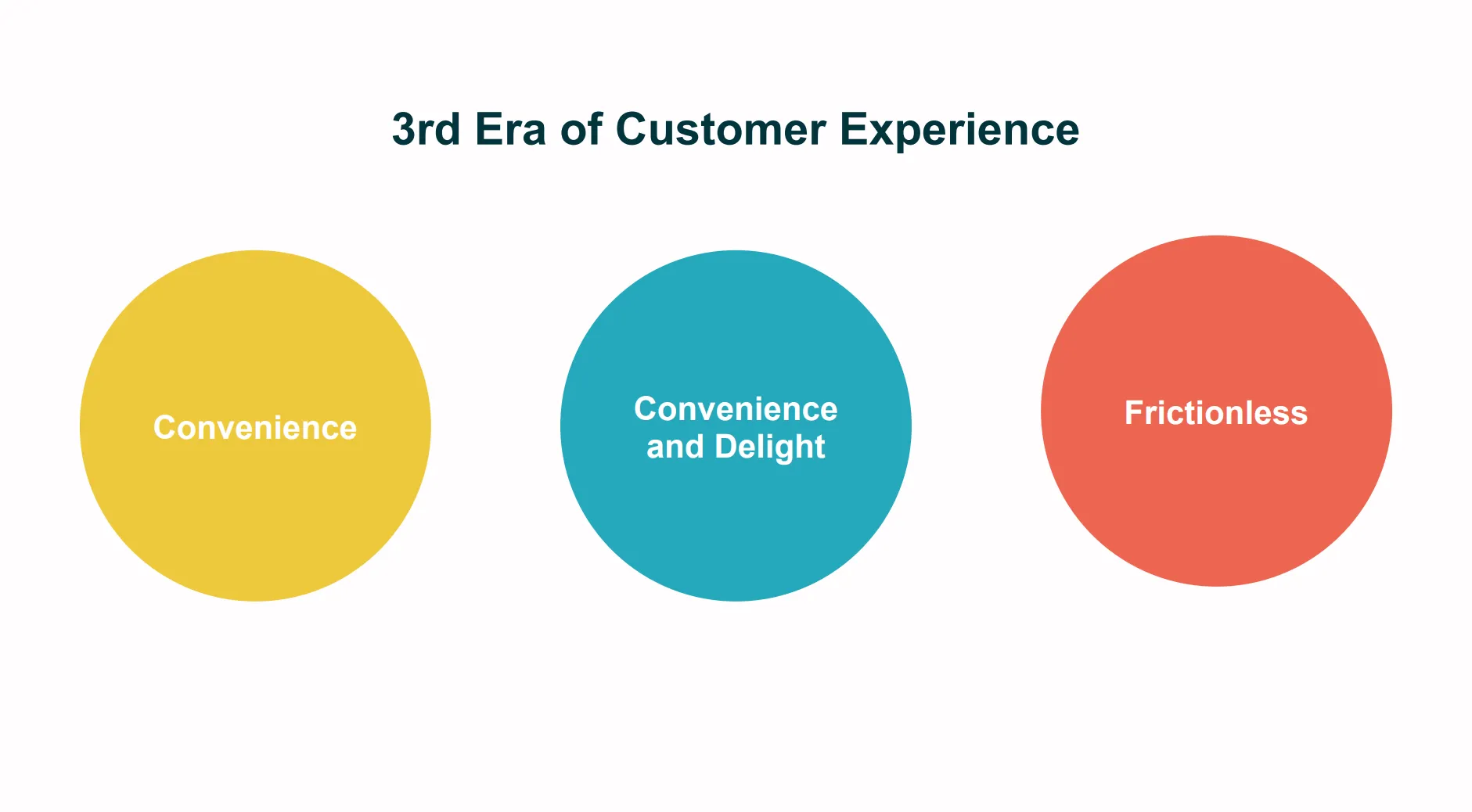
Image courtesy of Zendesk. All rights reserved.
How to Perform in the Frictionless Era of Customer Experience
So, now that we know we are in an entirely new environment of customer expectations, what does “frictionless” really mean? How can companies cater to their clients, and how should companies adjust their methodologies to move from the second to third stage of Customer Experience?
Technological advances have provided customers access to information at all times. This is what Prelini means by a Frictionless Era:
“Customers have experienced a mind shift: They expect any desired information or service to be available, on any appropriate device, in context, at their precise moment of need.”
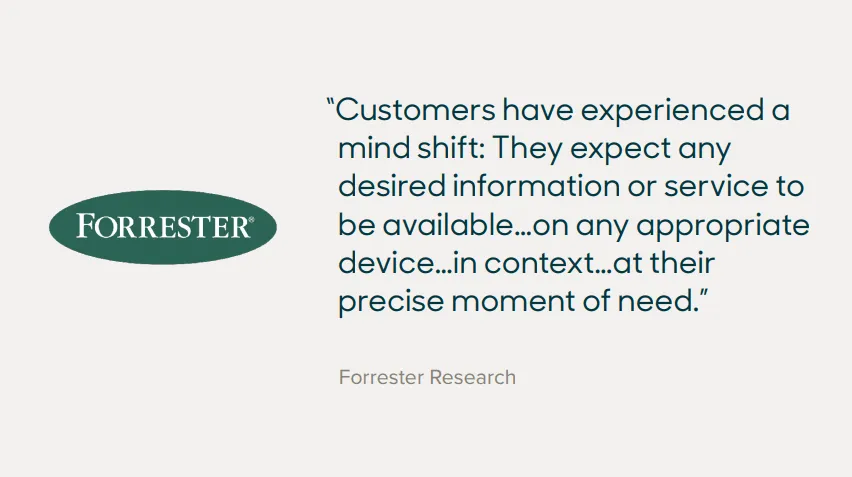
Companies can analyze the omnichannel preferences of their target groups and use this information to decide which method of communication is preferred by their customers. For instance, the majority of German customers prefer email and telephone contact. Let’s not dissatisfy our customer base by forcing face-to-face contact or messaging when it’s not desired. Find out your customers’ preferences and play them up!
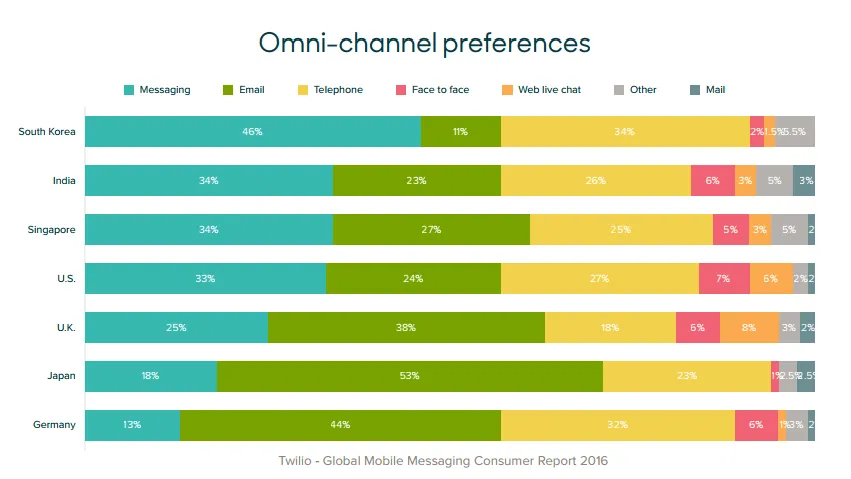
Prelini also made sure to touch on the fact that customers have the winning power in any relationship and, in today’s age, more so than ever! Customers are sharing their experiences with vendors online, and are more likely to voice their experience when it’s a negative one. Bad experiences are shared with others more than good experiences.
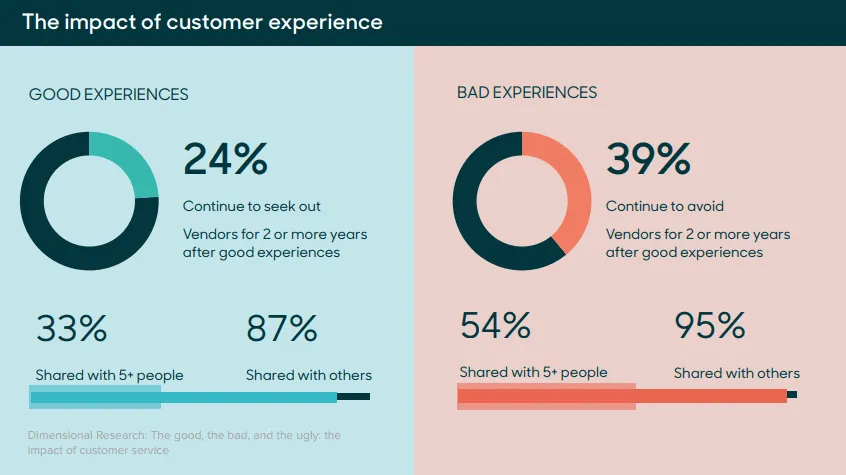
It’s extremely important companies focus on spanning multiple channels when forming the customer journey and customer experience. Prelini made sure to mention the positive impact live chat and chat bots can have on customer experience, causing my inner cheerleader to explode… technology will play an always more preponderant role in customer experience.
This is obviously connected to the fact that, unlike your local grocery store, large SaaS companies need to take care of thousands of incoming requests, potential customers, and users.
Scaling customer service as a whole is a challenge for modern businesses. The experience needs to be as smooth as possible but also tailored to each single customer’s specific needs. And unless SaaS companies suddenly decide to charge an arm and a leg for their monthly subscription plans to cover the costs of having swarms of agents, the only reasonable way to go is relying on modern technology. The key here is combining artificial intelligence and automation with human supervision.
A truly transparent customer experience requires a human touch! The perfect synergy between automation and direct contact with people creates the basis for a memorable customer journey that is both scalable and personalized.
The Evolution of Customer Service
To round out her presentation, Prelini left off with a powerful quote from Gartner stating that by 2020, customers will manage 85% of their relationships with enterprises without any human interaction.
This opens the door to a series of new questions and issues that companies need to address in order to make sure that people feel properly guided throughout their customer journey knowing that at some point they can always rely on the fact that a real person will be in charge of their success.
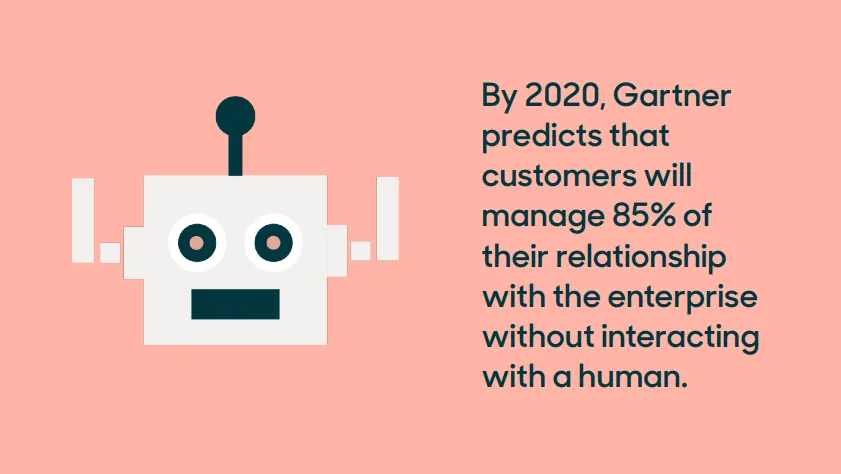
Image courtesy of Zendesk. All rights reserved.
Artificial Intelligence and Customer Experience, the Future is Now
Adrian McDermott, the President of Products at Zendesk, was next to speak on the topic of Artificial Intelligence. Now, if you were to ask me what AI meant half a year ago, I wouldn’t even know where to begin or what those two words strung together even mean for customers and companies.
Those two words, ‘Artificial Intelligence’, presented a challenge I suddenly needed to tackle if I wanted to understand the field of Customer Experience. This is why Adrian’s presentation piqued and latched on to my attention. I was ready to learn more about AI and the integration of it with Customer Experience in the future. Or now…actually!
Technology and the Social Revolutions
Adrian walked the audience through the industrial revolutions of our economy: the first being the Agricultural Revolution.
In the 1600’s, drastic changes in farming processes made farms more productive and work loads smaller. With this, people were able to leave the farms and go to the city. This influx of workers in the city ignited the Industrial Revolution.
The Industrial Revolution was characterized by an emergence of mechanization, coal extraction, and steam engines. The use of new technologies allowed the following Informational Revolution to take suit. Here, humans rely on the use of automated machines in warehouses. Mass computerization has taken place in small aspects of everyday life, from the personal computer, to major company decisions, such as replacing infrastructure and new investments.
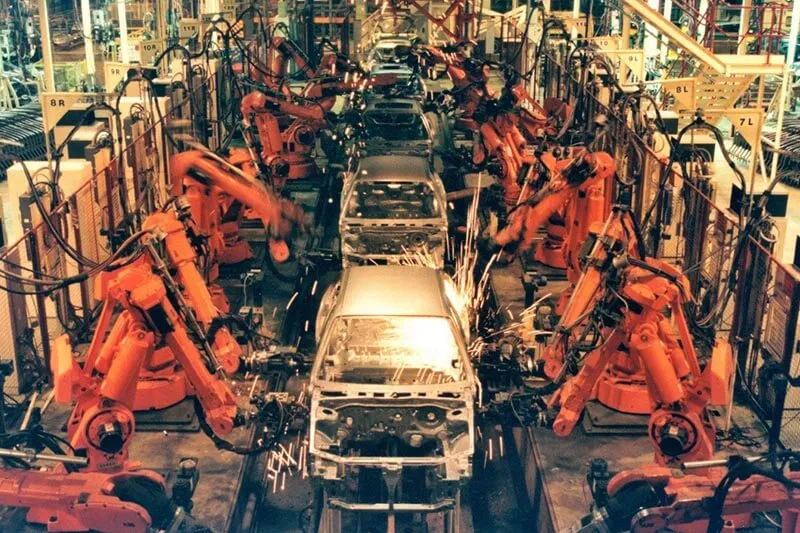
Image courtesy of Zendesk. All rights reserved.
It’s a common concern that the implementations of Artificial Intelligence will lead to mass unemployment (a dominant public figure even based part of his presidential campaign on this notion, after all!) I absolutely loved learning about a study Adrian shared that showed the correlation between ATM machines and employed tellers at the turn of the century.
While people feared that ATMs would completely replace bank clerks, banks soon realized that their clients really wanted to talk to actual human beings, and automation only led banks to expand and open more branches forcing them to hire even more employees than before.
Does Automation lead to Mass Unemployment?
Around 1970, many people feared they would lose their jobs as tellers if ATMs were installed.This technological advancement, which is of absolute normalcy to bank goers today, faced stark resistance from society. Needless to say, the ATMs were eventually installed. The result, however, was surprising to everyone. The ATMs actually led to an increase in need for more tellers. When analyzing the relationship between the number of tellers employed and ATMs installed, you can see they positively correlate. In the begining, bank goers needed assistance from tellers with the machines. Additionally, ATMs brought in more clients and more tellers were needed to serve the growing client base in capacities ATMs couldn’t provide.
I couldn’t help but chuckle to myself. It’s become just general rhetoric for people to insult the informational age and technological advancements, as it would hurt the working class. But here, Adrian provided an excellent counter.
Robots:1 Pessimists:0
This doesn’t mean that automation in general doesn’t represent a risk. This example, though, implies that we can’t be absolutely certain about the outcomes brought in by the advent of new technologies. We need to think proactively and try to foresee potential disruptions to the weaves of our society, but we also need to be aware of the fact that things might go in a very different direction than expected.
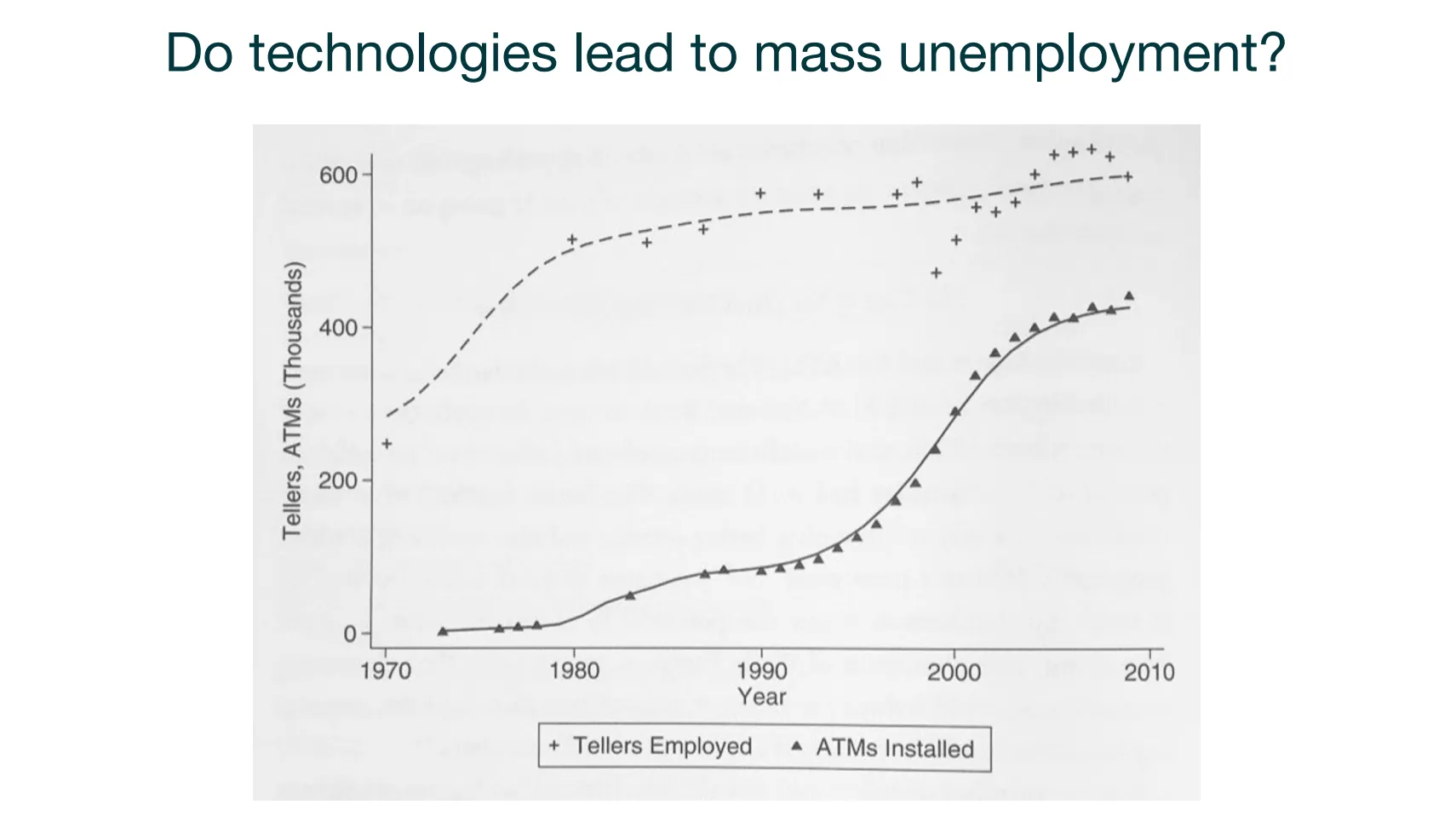
Image courtesy of Zendesk. All rights reserved.
At this point I’m eagerly awaiting Adrian’s next slides. He’s just established his authority and common ground by demonstrating how technology can lead to improvements in the workforce. Now, answer my question burning within: how can it enhance the Customer Experience!?
Quite simply put, AI removes repetitive work.
Automation and Customer Experience
Adrian walked the audience through a “No Thank You” predictive model that saves Customer Success agents time, and companies money.
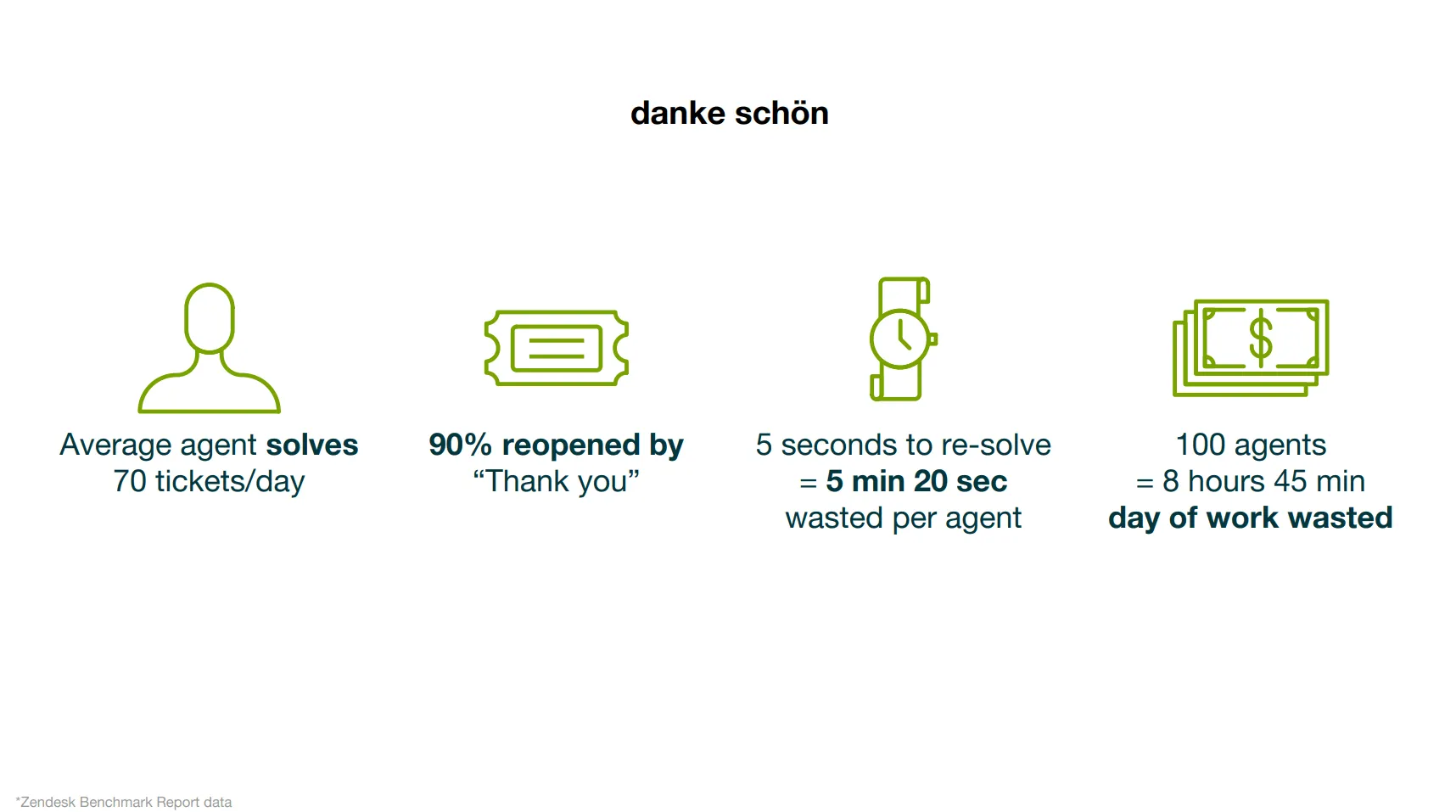
Image courtesy of Zendesk. All rights reserved.
This “No Thank You” tool, recognizes if a reply received by a Customer Success Manager or Customer Service representative is saying “Thank you” or something similar. If it is, the ticket is tagged and automatically solved. Of course, these tickets which are auto-solved can be reviewed at any time.
The results of this tiny integration are massive. The “No Thank You” integration saves, on average, 8 hours and 45 minutes of the work day from being wasted for every 100 agents.
Make People Smarter and More Efficient
Adrian also went on to explain how AI can make people smarter. It was interesting to see how Artificial Intelligence integrations not only reduce repetitive and brain numbing tasks, but also enhance the productivity and quality of work in humans.
Take for instance an app that updates you in real time on the status of your flight from Amsterdam to San Francisco. It presents you with your boarding pass so you can avoid excessively long check-in lines. Additionally, it immediately alerts you with a delay or potential gate change.
This way, you spend less time frustrated at your terminal fuming over all the time you’ll soon waste, instead deciding to head to the lounge, kick back in a large arm chair, order a beer, and -finally- call that worried mother of yours! Now, I don’t know about you, but a cold IPA sounds way better than angrily live-tweeting something I have no control over.
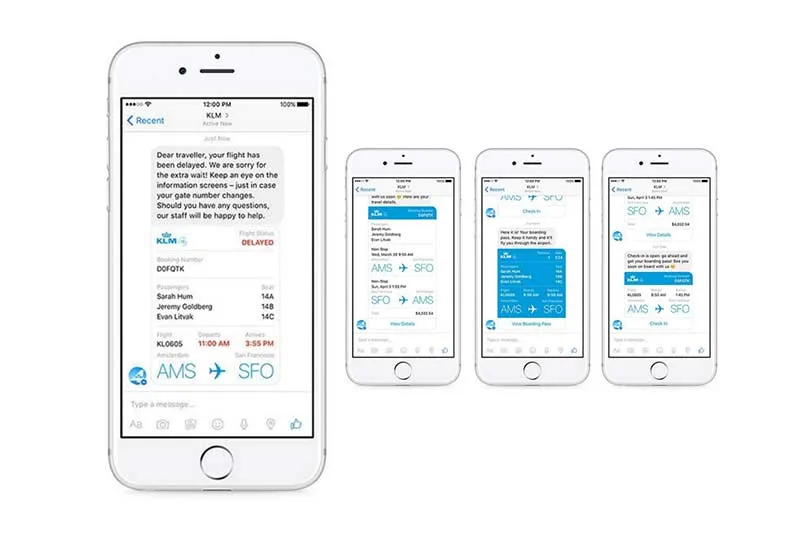
Image courtesy of Zendesk. All rights reserved.
The Future of Customer Experience
By now Adrian had sold me on the benefits of Artificial Intelligence, but how would it play out in the future of Customer Experience? Why was CX so important to pay attention to in the world of Customer Success and Customer Service?
For starters, Adrian shared how 86% of buyers will pay more for a better Customer Experience.
Something that truly shocked me was that by 2020, Customer Experience will overtake price and product as the key brand differentiator!
This means companies need to focus the majority of their efforts on Customer Experience and should really start implementing AI to create fluid experiences and enhance Customer Success programs for their clients. Brands are capturing their client base with great Customer Experience, and to not focus on this would be detrimental to a company’s success.
Through a case study with TravelBird, I learned how this particular company solved their problem of increased volume and rising expectations from customers (a major “problem” any company would like to have!).
To solve this, they integrated DigitalGenius, an automated question answering tool which let the computers and AI resolve tickets in multiple languages and platforms. This way, Customer Success Experts were allotted the time to do what they do best and resolve issues that needed real human connection.
With this integration, TravelBirds increased Artificial Intelligence involvement to 65% and witnessed a decrease of 42% in Average Handle Time (AHT), which was paired with a 95% result accuracy from the AI!
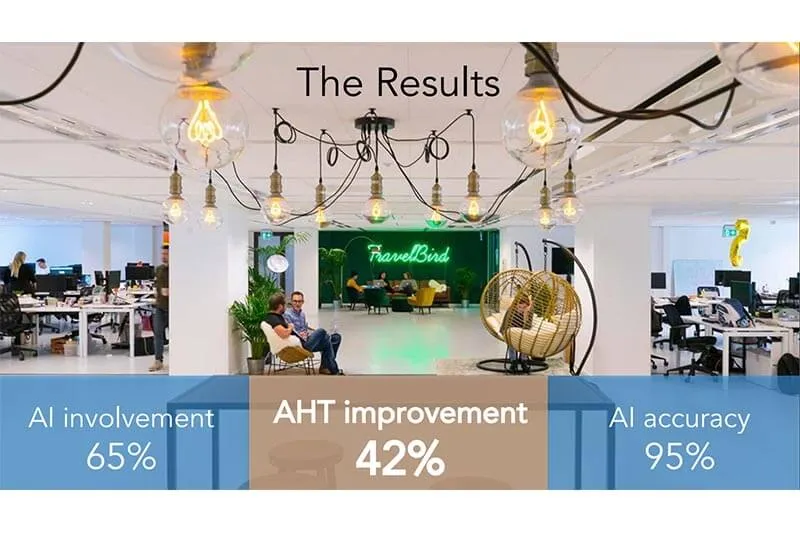
Image courtesy of Zendesk. All rights reserved.
Again, the important fact to highlight here is that humans are responsible for supervising chatbots. Replies associated to requests are scored by the system on the basis of how likely it is for an answer to be relevant.
Agents, can set a threshold and decide to let bots deal with messages if the certainty level is above 85% for example. Any other request is then dealt with manually.
Bots are monitored and become always more accurate through the interaction with human supervisors and little by little they can cope with always more complex requests that aren’t specifically yes or no questions or simple inquiries such as price, lead time, and such.
Final Thoughts on the CX Council Event and Key Takeaways
I learned a lot from the Zendesk CX Council and am so incredibly thankful to Linda Kuniss, the Zendesk Field Marketing Manager of Central Europe, for extending an invitation to participate in this event.
I left with a firmer understanding of the current state of Customer Experience, and how companies are moving forward towards implementing Artificial Intelligence to effectively serve the needs of their customers in this frictionless era of Customer Experience.
After the informational event, Linda led our pack of Customer Success aficionados to the Oktoberfest tents. There, I ate my body mass in pretzels, enjoyed delicious Bavarian beer, and sang “Ein Prosit” louder than my neighbor. Zendesk surely ensures the happiness of their customers and partners – I could get used to this!
Zendesk also demonstrated the way they cater to customer needs, going out of their way to provide separate menu options when I told them I was vegan (an obstacle at the Oktoberfest, one can rightfully assume). I greatly appreciated this tiny gesture, which showed me how a company can tend to the needs of individuals to make them feel important.
It was a great ending to an educational evening and something I made sure to share with the rest of my team at Userlane. Putting the needs of a customer above everything else will always leave the lasting impressions- no matter how small.
If you’re interested in customer experience and customer success and want to know more about it, check out our roundup post in which some of the top customer service authorities tackle some of the most common customer success issues and present their strategies and tactics. The ultimate customer success playbook!

